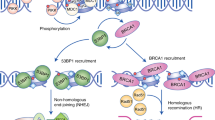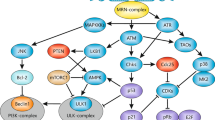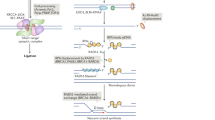Abstract
The inability to repair DNA damage properly in mammals leads to various disorders and enhanced rates of tumour development. Organisms respond to chromosomal insults by activating a complex damage response pathway. This pathway regulates known responses such as cell-cycle arrest and apoptosis (programmed cell death), and has recently been shown to control additional processes including direct activation of DNA repair networks.
This is a preview of subscription content, access via your institution
Access options
Subscribe to this journal
Receive 51 print issues and online access
$199.00 per year
only $3.90 per issue
Buy this article
- Purchase on Springer Link
- Instant access to full article PDF
Prices may be subject to local taxes which are calculated during checkout



Similar content being viewed by others
References
George, J., Castellazzi, M. & Buttin, G. Prophage induction and cell division in E. coli. III. Mutations sfiA and sfiB restore division in tif and lon strains and permit the expression of mutator properties of tif. Mol. Gen. Genet. 140, 309– 332 ( 1975).
Painter, R. B. & Young, B. R. Radiosensitivity in ataxia-telangiectasia: A new explanation. Proc. Natl Acad. Sci. USA 77, 7315– 7317 (1980).
Weinert, T. A. & Hartwell, L. H. The RAD9 gene controls the cell cycle response to DNA damage in Saccharomyces cerevisiae. Science 241, 317– 322 ( 1988).
Cortez, D., Wang, Y., Qin, J. & Elledge, S. J. Requirement of ATM-dependent phosphorylation of brca1 in the DNA damage response to double-strand breaks. Science 286, 1162– 1166 (1999).
Lim, D. S. et al. ATM phosphorylates p95/nbs1 in an S-phase checkpoint pathway. Nature 404, 613– 617 (2000).
Gatei, M. et al. ATM-dependent phosphorylation of nibrin in response to radiation exposure. Nature Genet. 25, 115– 119 (2000).
Zhao, S. et al. Functional link between ataxia-telangiectasia and Nijmegen breakage syndrome gene products. Nature 405, 473– 477 (2000).
Wu, X. et al. ATM phosphorylation of Nijmegen breakage syndrome protein is required in a DNA damage response. Nature 405, 477 – 482 (2000).
Martin, S. G., Laroche, T., Suka, N., Grunstein, M. & Gasser, S. M. Relocalization of telomeric Ku and SIR proteins in response to DNA strand breaks in yeast. Cell 97, 621– 633 (1999).
Mills, K. D., Sinclair, D. A. & Guarente, L. MEC1-dependent redistribution of the Sir3 silencing protein from telomeres to DNA double-strand breaks. Cell 97, 609– 620 (1999).
Elledge, S. J. Cell cycle checkpoints: preventing an identity crisis. Science 274, 1664– 1672 ( 1996).
Naito, T., Matsuura, A. & Ishikawa, F. Circular chromosome formation in a fission yeast mutant defective in two ATM homologues. Nature Genet. 20, 203– 206 (1998).
Ritchie, K. B., Mallory, J. C. & Petes, T. D. Interactions of TLC1 (which encodes the RNA subunit of telomerase), TEL1, and MEC1 in regulating telomere length in the yeast Saccharomyces cerevisiae. Mol. Cell. Biol. 19, 6065– 6075 (1999).
Lowe, S. W., Schmitt, E. M., Smith, S. W., Osborne, B. A. & Jacks, T. p53 is required for radiation-induced apoptosis in mouse thymocytes. Nature 362, 847– 849 (1993).
Clarke, A. R. et al. Thymocyte apoptosis induced by p53-dependent and independent pathways. Nature 362, 849– 852 (1993).
Xu, Y. & Baltimore, D. Dual roles of ATM in the cellular response to radiation and in cell growth control. Genes Dev. 10, 2401– 2410 (1996).
Hirao, A. et al. DNA damage-induced activation of p53 by the checkpoint kinase Chk2. Science 287, 1824– 1827 (2000).
Brown, E. J. & Baltimore, D. ATR disruption leads to chromosomal fragmentation and early embryonic lethality. Genes Dev. 14, 397– 402 (2000).
de Klein, A. et al. Targeted disruption of the cell-cycle checkpoint gene ATR leads to early embryonic lethality in mice. Curr. Biol. 10, 479– 482 (2000).
Liu, Q. et al. Chk1 is an essential kinase that is regulated by Atr and required for the G(2)/M DNA damage checkpoint. Genes Dev. 14 , 1448– 1459 (2000).
Takai, H. et al. Aberrant cell cycle checkpoint function and early embryonic death in Chk1(-/-) mice. Genes Dev. 14, 1439– 1447 (2000).
Rotman, G. & Shiloh, Y. Ataxia-telangiectasia: is ATM a sensor of oxidative damage and stress? BioEssays 19, 911– 917 (1997).
Sun, Z., Hsiao, J., Fay, D. S. & Stern, D. F. Rad53 FHA domain associated with phosphorylated Rad9 in the DNA damage checkpoint. Science 281, 272– 274 ( 1998).
Emili, A. MEC1-dependent phosphorylation of Rad9p in response to DNA damage. Mol. Cell 2, 183– 189. ( 1998).
Vialard, J. E., Gilbert, C. S., Green, C. M. & Lowndes, N. F. The budding yeast Rad9 checkpoint protein is subjected to Mec1/Tel1-dependent hyperphosphorylation and interacts with Rad53 after DNA damage. EMBO J. 17, 5678– 5688 ( 1998).
Sanchez, Y. et al. Control of the DNA damage checkpoint by chk1 and rad53 protein kinases through distinct mechanisms. Science 286, 1166– 1171 (1999).
Durocher, D., Henckel, J., Fersht, A. R. & Jackson, S. P. The FHA domain is a modular phosphopeptide recognition motif. Mol. Cell 4, 387– 394 ( 1999).
Liao, H., Byeon, I. J. & Tsai, M. D. Structure and function of a new phosphopeptide-binding domain containing the FHA2 of Rad53. J. Mol. Biol. 294, 1041– 1049 (1999).
Wang, Z. Q. et al. Mice lacking ADPRT and poly(ADP-ribosyl)ation develop normally but are susceptible to skin disease. Genes Dev. 9, 509– 520 (1995).
Jimenez, G. S. et al. DNA-dependent protein kinase is not required for the p53-dependent response to DNA damage. Nature 400, 81– 83 (1999).
O'Connell, M. J., Walworth, N. C. & Carr, A. M. The G2-phase DNA damage checkpoint. Trends Cell Biol. 10, 296– 303 ( 2000).
Volkmer, E. & Karnitz, L. M. Human homologs of Schizosaccharomyces pombe rad1, hus1, and rad9 form a DNA damage-responsive protein complex. J. Biol. Chem. 274, 567– 570 (1999).
Weiss, R. S., Enoch, T. & Leder, P. Inactivation of mouse hus1 results in genomic instability and impaired responses to genotoxic stress. Genes Dev. 14, 1886– 1898 (2000).
Sugimoto, K., Ando, S., Shimomura, T. & Matsumoto, K. Rfc5, a replication factor C component, is required for regulation of Rad53 protein kinase in the yeast checkpoint pathway. Mol. Cell. Biol. 17, 5905– 5914 (1996).
Noskov, V. N., Araki, H. & Sugino, A. The RFC2 gene, encoding the third-largest subunit of the replication factor C complex, is required for an S-phase checkpoint in Saccharomyces cerevisiae. Mol. Cell. Biol. 18, 4914– 4923 (1998).
Shimomura, T., Ando, S., Matsumoto, K. & Sugimoto, K. Functional and physical interaction between Rad24 and Rfc5 in the yeast checkpoint pathways. Mol. Cell. Biol. 18, 5485– 5491 (1998).
Shimada, M. et al. Replication factor C3 of Schizosaccharomyces pombe, a small subunit of replication factor C complex, plays a role in both replication and damage checkpoints. Mol. Biol. Cell 10, 3991– 4003 (1999).
Green, C. M., Erdjument-Bromage, H., Tempst, P. & Lowndes, N. F. A novel Rad24 checkpoint protein complex closely related to replication factor C. Curr. Biol. 10, 39– 42 (2000).
Edwards, R. J., Bentley, N. J. & Carr, A. M. A Rad3-Rad26 complex responds to DNA damage independently of other checkpoint proteins. Nature Cell Biol. 1, 393– 398 (1999).
Paciotti, V., Clerici, M., Lucchini, G. & Longhese, M. P. The checkpoint protein Ddc2, functionally related to S. pombe Rad26, interacts with Mec1 and is regulated by Mec1-dependent phosphorylation in budding yeast. Genes Dev. 14, 2046– 2059 (2000).
Rouse, J. & Jackson, S. P. LCD1: An essential gene involved in checkpoint control and regulation of the MEC1 signalling pathway in Saccharomyces cerevisiae. EMBO J. 19, 5801– 5812 (2000).
Xu, X. et al. Centrosome amplification and a defective G2-M cell cycle checkpoint induce genetic instability in BRCA1 exon 11 isoform-deficient cells. Mol. Cell 3, 389– 395 ( 1999).
Wang, Y. et al. BASC, a super complex of BRCA1-associated proteins involved in the recognition and repair of aberrant DNA structures. Genes Dev. 14, 927– 939 ( 2000).
Gong, J. G. et al. The tyrosine kinase c-Abl regulates p73 in apoptotic response to cisplatin-induced DNA damage. Nature 399, 806– 809 (1999).
Kastan, M. B. et al. A mammalian cell cycle checkpoint pathway utilizing p53 and GADD45 is defective in ataxia-telangiectasia. Cell 71, 587– 597 (1992).
Paules, R. S. et al. Defective G2 checkpoint function in cells from individuals with familial cancer syndromes. Cancer Res. 55, 1763– 1773 (1995).
Cliby, W. A. et al. Overexpression of a kinase-inactive ATR protein causes sensitivity to DNA-damaging agents and defects in cell cycle checkpoints. EMBO J. 17, 159– 169 ( 1998).
Wright, J. A. et al. Protein kinase mutants of human ATR increase sensitivity to UV and ionizing radiation and abrogate cell cycle checkpoint control. Proc. Natl Acad. Sci. USA 95, 7445– 7450 (1998).
Kim, S. T., Lim, D. S., Canman, C. E. & Kastan, M. B. Substrate specificities and identification of putative substrates of ATM kinase family members. J. Biol. Chem. 274, 37538 – 37543 (1999).
Canman, C. E. et al. Activation of the ATM kinase by ionizing radiation and phosphorylation of p53. Science 281, 1677– 1679 (1998).
Banin, S. et al. Enhanced phosphorylation of p53 by ATM in response to DNA damage. Science 281, 1674– 1677 (1998).
Tibbetts, R. S. et al. A role for ATR in the DNA damage-induced phosphorylation of p53. Genes Dev. 13, 152– 157 (1999).
Tibbetts, R. S. et al. Functional interactions between BRCA1 and the checkpoint kinase ATR during genotoxic stress. Genes Dev. (in the press).
Barlow, C. et al. Atm-deficient mice: a paradigm of ataxia telangiectasia. Cell 86, 159– 171 ( 1996).
Elson, A. et al. Pleiotropic defects in ataxia-telangiectasia protein-deficient mice. Proc. Natl Acad. Sci. USA 93, 13084 – 13089 (1996).
Desany, B. A., Alcasabas, A. A., Bachant, J. B. & Elledge, S. J. Recovery from DNA replicational stress is the essential function of the S-phase checkpoint pathway. Genes Dev. 12, 2956– 2970 (1998).
Khanna, K. K. et al. ATM associates with and phosphorylates p53: mapping the region of interaction. Nature Genet. 20, 398– 400 (1998).
Chan, D. W. et al. Purification and characterization of ATM from human placenta. A manganese-dependent, wortmannin-sensitive serine/threonine protein kinase. J. Biol. Chem. 275, 7803– 7810 (2000).
Smith, G. C. et al. Purification and DNA binding properties of the ataxia-telangiectasia gene product ATM. Proc. Natl Acad. Sci. USA 96, 11134– 11139 (1999).
Lakin, N. D., Hann, B. C. & Jackson, S. P. The ataxia-telangiectasia related protein ATR mediates DNA-dependent phosphorylation of p53. Oncogene 18, 3989– 3995 (1999).
Hall-Jackson, C. A., Cross, D. A., Morrice, N. & Smythe, C. ATR is a caffeine-sensitive, DNA-activated protein kinase with a substrate specificity distinct from DNA-PK. Oncogene 18, 6707– 6713 (1999).
Matsuoka, S., Huang, M. & Elledge, S. J. Linkage of ATM to cell cycle regulation by the Chk2 protein kinase. Science 282, 1893– 1897 (1998).
Blasina, A. et al. A human homologue of the checkpoint kinase Cds1 directly inhibits Cdc25 phosphatase. Curr. Biol. 9, 1– 10 (1999).
Brown, A. L. et al. A human Cds1-related kinase that functions downstream of ATM protein in the cellular response to DNA damage. Proc. Natl Acad. Sci. USA 96, 3745– 3750 ( 1999).
Chaturvedi, P. et al. Mammalian Chk2 is a downstream effector of the ATM-dependent DNA damage checkpoint pathway. Oncogene 18, 4047– 4054 (1999).
Zhou, B.-B. S. et al. Caffeine abolishes the mammalian G2/M DNA damage checkpoint by inhibiting ataxia-telangiectasia-mutated kinase activity. J. Biol. Chem. 275, 10342– 10348 (2000).
Matsuoka, S. et al. ATM phosphorylates Chk2 in vivo and in vitro. Proc. Natl Acad. Sci. USA 97, 10389– 10394 (2000).
Melchionna, R., Chen, X., Blasina, A. & McGowan, C. H. Threonine 68 is required for radiation-induced phosphorylation and activation of Cds1. Nature Cell Biol. 2, 762– 765 (2000).
Chehab, N. H., Malikzay, A., Appel, M. & Halazonetis, T. D. Chk2/hCds1 functions as a DNA damage checkpoint in G(1) by stabilizing p53. Genes Dev. 14, 278– 288 ( 2000).
Shieh, S. Y., Ahn, J., Tamai, K., Taya, Y. & Prives, C. The human homologs of checkpoint kinases Chk1 and Cds1 (Chk2) phosphorylate p53 at multiple DNA damage-inducible sites. Genes Dev. 14, 289– 300 ( 2000).
Chehab, N. H., Malikzay, A., Stavridi, E. S. & Halazonetis, T. D. Phosphorylation of Ser-20 mediates stabilization of human p53 in response to DNA damage. Proc. Natl Acad. Sci. USA 96, 13777– 13782 (1999).
Ashcroft, M., Kubbutat, M. H. & Vousden, K. H. Regulation of p53 function and stability by phosphorylation. Mol. Cell. Biol. 19, 1751– 1758 (1999).
Khosravi, R. et al. Rapid ATM-dependent phosphorylation of MDM2 precedes p53 accumulation in response to DNA damage. Proc. Natl Acad. Sci. USA 96, 14973– 14977 (1999).
Bell, D. W. et al. Heterozygous germ line hCHK2 mutations in Li-Fraumeni syndrome. Science 286, 2528– 2531 (1999).
Lee, J. S., Collins, K. M., Brown, A. L., Lee, C. H. & Chung, J. H. hCds1-mediated phosphorylation of BRCA1 regulates the DNA damage response. Nature 404, 201– 204 (2000).
Sanchez, Y. et al. Conservation of the Chk1 checkpoint pathway in mammals: linkage of DNA damage to Cdk regulation through Cdc25. Science 277, 1497– 1501 (1997).
Walworth, N. C. & Bernards, R. rad-dependent response of the chk1-encoded protein kinase at the DNA damage checkpoint. Science 271, 353– 356 (1996).
Nurse, P. Checkpoint pathways come of age. Cell 91, 865– 867 (1997).
Morgan, D. O. Principles of CDK regulation. Nature 374, 131– 134 (1995).
Peng, C. Y. et al. Mitotic and G2 checkpoint control: regulation of 14-3-3 protein binding by phosphorylation of Cdc25C on serine-216. Science 277, 1501– 1505 (1997).
Dalal, S. N., Schweitzer, C. M., Gan, J. & DeCaprio, J. A. Cytoplasmic localization of human cdc25C during interphase requires an intact 14-3-3 binding site. Mol. Cell. Biol. 19, 4465– 4479 (1999).
Yang, J., Winkler, K., Yoshida, M. & Kornbluth, S. Maintenance of G2 arrest in the Xenopus oocyte: a role for 14-3-3-mediated inhibition of Cdc25 nuclear import. EMBO J. 18, 2174 – 2183 (1999).
Bunz, F. et al. Requirement for p53 and p21 to sustain G2 arrest after DNA damage. Science 282, 1497– 1501 (1998).
Chan, T. A., Hermeking, H., Lengauer, C., Kinzler, K. W. & Vogelstein, B. 14-3-3 Sigma is required to prevent mitotic catastrophe after DNA damage. Nature 401, 616– 620 (1999).
Jelinsky, S. A. & Samson, L. D. Global response of Saccharomyces cerevisiae to an alkylating agent. Proc. Natl Acad. Sci. USA 96, 1486– 1491 (1999).
Hwang, B. J., Ford, J. M., Hanawalt, P. C. & Chu, G. Expression of the p48 xeroderma pigmentosum gene is p53-dependent and is involved in global genomic repair. Proc. Natl Acad. Sci. USA 96, 424– 428 (1999).
Tanaka, H. et al. A ribonucleotide reductase gene involved in a p53-dependent cell-cycle checkpoint for DNA damage. Nature 404, 42– 49 (2000).
Carney, J. P. et al. The hMre11/hRad50 protein complex and Nijmegen breakage syndrome: linkage of double-strand break repair to the cellular DNA damage response. Cell 93, 477– 486 (1998).
Stewart, G. S. et al. The DNA double-strand break repair gene hMRE11 is mutated in individuals with an ataxia-telangiectasia-like disorder. Cell 99, 577– 587 ( 1999).
Jeggo, P. A., Carr, A. M. & Lehmann, A. R. Splitting the ATM: distinct repair and checkpoint defects in ataxia-telangiectasia. Trends Genet. 14, 312– 316 (1998).
Moynahan, M. E., Chiu, J. W., Koller, B. H. & Jasin, M. Brca1 controls homology-directed DNA repair. Mol. Cell 4, 511– 518 (1999).
Bashkirov, V. I., King, J. S., Bashkirova, E. V., Schmuckli-Maurer, J. & Heyer, W. D. DNA repair protein Rad55 is a terminal substrate of the DNA damage checkpoints. Mol. Cell. Biol. 20, 4393– 4404 (2000).
Brush, G. S., Morrow, D. M., Hieter, P. & Kelly, T. J. The ATM homologue MEC1 is required for phosphorylation of replication protein A in yeast. Proc. Natl Acad. Sci. USA 93, 15075– 15080 (1996).
Lydall, D. & Weinert, T. Yeast checkpoint genes in DNA damage processing: implications for repair and arrest. Science 270, 1488– 1491 (1995).
Bochar, D. A. et al. BRCA1 is associated with a human SWI/SNF-related complex: linking chromatin remodeling to breast cancer. Cell 102, 257– 265 (2000).
Gasser, S. M. A sense of the end. Science 288, 1377– 1379 (2000).
Acknowledgements
We thank A. Carr, D. Cortez, M. Mattern, M. Huang, L. Zou, M. Tetzlaff and T. Weinert for comments on the manuscript.
Author information
Authors and Affiliations
Corresponding author
Rights and permissions
About this article
Cite this article
Zhou, BB., Elledge, S. The DNA damage response: putting checkpoints in perspective. Nature 408, 433–439 (2000). https://doi.org/10.1038/35044005
Issue Date:
DOI: https://doi.org/10.1038/35044005
This article is cited by
-
Four classic “de novo” genes all have plausible homologs and likely evolved from retro-duplicated or pseudogenic sequences
Molecular Genetics and Genomics (2024)
-
Heterogeneous expression of ARID1A in colorectal cancer indicates distinguish immune landscape and efficacy of immunotherapy
Discover Oncology (2024)
-
Biomedical association analysis between G2/M checkpoint genes and susceptibility to HIV-1 infection and AIDS progression from a northern chinese MSM population
AIDS Research and Therapy (2023)
-
Contaminants from dredged sediments alter the transcriptome of Manila clam and induce shifts in microbiota composition
BMC Biology (2023)
-
C11orf54 promotes DNA repair via blocking CMA-mediated degradation of HIF1A
Communications Biology (2023)
Comments
By submitting a comment you agree to abide by our Terms and Community Guidelines. If you find something abusive or that does not comply with our terms or guidelines please flag it as inappropriate.



